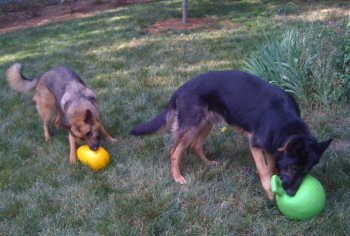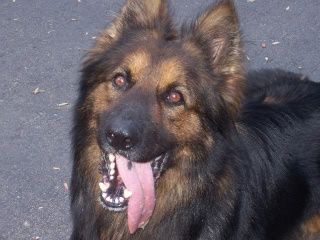I wonder if maybe your husband is too eager to be friends with him? That, or is he one of those folks who is "secretly" afraid of the dog but trying really hard to come across as though not afraid at all, thereby typically standing very rigidly and perhaps staring hard into the dogs eyes?
I have one 3 yo male who exhibits behaviors very similar to your dog's. When I acquired him at 5 months he was very nervous around all people (i know yours is ok with most), then he was just nervous around certain people. He was typically afraid of large or tall men, over-friendly strangers (the one that freak out when they see a GSD because they just "LOVE GSDS!!" therefor overwhelming the dog), and people who were really afraid of him but tried to pretend they weren't (these people give off really weired and mixed up signals, which really confuse and stress out a nervous dog like what you and I have).
Porter is now fine with anybody of any age. The number one factor in his rehabilitation was/is pack structure. You seem to already have a good understanding of how important this is.
Just take it a step further...
A nervous dog like our guys should never be allowed to approach people on his own, even in a friendly manner (if it's a person they end up being fearful of, and the dog is out of your control, i.e. ahead of you, then you have no control over the situation. A dog like this needs you to be in control of every situation. Always have him sit
beside you to say "hello".
If he's afraid of the person, just make him sit beside you and nothing more, then continue on with your dealings with the person as though the dog weren't there. Tell the person, including your husband "
NO TOUCH NO EYE CONTACT. This takes so much pressure off of the dog, *so* important for a skittish dog. For a fearful person, this puts them in a position of truly appearing to be an alpha dog, someone a nervous dog can begin to trust and an aggressive dog will eventually ignore. Your dog does not need to be "friendly" with everyone he meets, and if you put too much pressure (to be friendly) on the dog he will only become stressed.
If the dog hackles and growls at a person, correct him and insist that he simply sit or lay beside you and not interact with the person at all (similar to how you say he is with other dogs). This is pack structure at its best,
you choose to interact with the person regardless of what the dog thinks. Things will eventually click with the dog

Again, he does *not* have to be "friends" with everyone. He will come to be more comfortable with people (like your husband) that he encounters repetitively at his own pace, but they
have to behave as though the dog were not even there, even when the dog makes physical contact (usually via sniffing), otherwise the pressure will stress him out and create hostility. All it comes down to (for the dog) is that YOU control *everything* for him, all the way from people, to other dogs (i.e. your pack) to him and his behavior. A nervous dog needs an
absolute leader!
**
CRATE him off from the other dogs when you leave home!!! I understand your take on the way a pack should be able to coexist peacefully, I am able to do this with my own pack. *This dog is not stable enough to be left unsupervised with the rest of the pack*!! At 11 months, neither was Porter. Adolescence with Porter painted similar situation regarding the submissive behaviors mixed with the bossy behaviors (*not* dominant!), licking at one of the dogs' mouth and then trying to correct for excitable behavior the next. Even if you leave him in the same room (as I did) he must be crated until these issues are non-issues, however long it takes.
The only thing I can equate this behavior to is "brown-nosing"

Regardless, it is NOT a stable behavior and was/is not allowed, i.e. I will correct Porter for trying to "correct" another one of my dogs!
*****This is a really good reason to crate him when your gone ... there is no telling what he may be getting up to while your out, not to mention all the pack structure that is coming undone when he's left to make his own decisions (typically not-so-good ones with a dog like this)... and every bit of it eating away at all of the pack structure work you've been doing. *****

Synchronized Chomping
 Previous Topic
Previous Topic Index
Index Next Topic
Next Topic












 Again, he does *not* have to be "friends" with everyone. He will come to be more comfortable with people (like your husband) that he encounters repetitively at his own pace, but they have to behave as though the dog were not even there, even when the dog makes physical contact (usually via sniffing), otherwise the pressure will stress him out and create hostility. All it comes down to (for the dog) is that YOU control *everything* for him, all the way from people, to other dogs (i.e. your pack) to him and his behavior. A nervous dog needs an absolute leader!
Again, he does *not* have to be "friends" with everyone. He will come to be more comfortable with people (like your husband) that he encounters repetitively at his own pace, but they have to behave as though the dog were not even there, even when the dog makes physical contact (usually via sniffing), otherwise the pressure will stress him out and create hostility. All it comes down to (for the dog) is that YOU control *everything* for him, all the way from people, to other dogs (i.e. your pack) to him and his behavior. A nervous dog needs an absolute leader! Regardless, it is NOT a stable behavior and was/is not allowed, i.e. I will correct Porter for trying to "correct" another one of my dogs!
Regardless, it is NOT a stable behavior and was/is not allowed, i.e. I will correct Porter for trying to "correct" another one of my dogs!
 Top
Top




